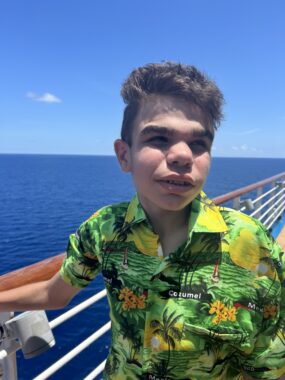Taking a risk pays off during a cruise with our son, who has Sanfilippo
International travel isn't easy with Sanfilippo, but a cruise was a good call
Written by |

It’s another season of chaos in our house. I don’t know why I’m surprised. Chaos is our normal.
Life with our son, Will, who has Sanfilippo syndrome, is rarely easy. Sometimes the challenges we face are expected, given his condition. But other times they are things we never anticipated. Each day, I feel like new problems pop up left and right, and we have to invent new strategies to deal with them.
Thankfully, we’ve been doing this long enough to have a stockpile of resources at home to manage, or at least mitigate, the difficulties. Our home and routines are our refuge. We can handle anything that happens.
So, of course, I had the bright idea of taking our pandemonium to sea!
A special birthday
Will celebrated his 13th birthday this summer. With life expectancy of Sanfilippo patients, according to one study, ranging from 15 to 23 years old, depending on the type, the ticking of my internal clock of concern grows ever louder with each birthday. We have no time to waste. I felt the urge again to “get busy living or get busy dying.” I booked a cruise.
Even with Will’s recent feeding challenges, he is still largely doing well. We want our boy to see and experience as much of this world as he can while he is healthy enough to travel. Our family has been fortunate to be able to visit many locations in the United States, but I want Will to have stamps in his passport.
Long flights aren’t really an option for him, but we wanted to give him several new experiences. We decided that a cruise with a stateroom that Will could settle into and with lots of food options would at least be worth trying. I hoped that a solid week on the ship would allow some type of routine to be established.
Dolphins, ice cream, and an abundance of joy
It was not easy taking our show on the road (or rather, on the ocean). There are so many things to consider, not just regarding Will’s care, but also how Will is viewed and treated by others.
The first day was incredibly stressful, and we nearly regretted our decision. But by the end of the trip, we were surprised by how well everything went. We managed to learn to navigate the ship and survived our excursions to three countries!
We were also pleasantly surprised by how kind people were. As I mentioned, the stress of how people interact — or choose not to interact — with Will can be incredibly upsetting and disheartening. Thankfully, this was not an issue. Employees and guides took the time to learn Will’s name and made sure to address and include him.
Other families who began to notice us around the boat would make sure to hold elevators or give us room to move forward in lines. People were willing to help. No one minded waiting for Will or making sure he had accessible seating or viewing. One day, when I was walking with Will on the upper outer deck (his favorite activity on the ship), a strong gust of wind caught my hat and blew it down several decks to the pool area. I was shocked when strangers who saw what happened ran to get it for me so that I didn’t have to walk with Will down the stairs!
But the real shining star was how much Will enjoyed himself and how much we enjoyed our time together as a family. Will got to swim with dolphins, play in the ocean, explore Mayan ruins, sample new cuisine, and eat ice cream every day. He loved the walking track and the splash pad. He smiled and looked incredibly handsome while wearing every tropical shirt in his collection. And those smiles brought a lot of joy to the people he met.
We broke our routine and took a chance so that Will could see more of the world. I knew that part was important. What I didn’t realize was how important it was for the world to see more of Will. He inspires the best in me, so why wouldn’t he inspire the best in others? The trip was worth it just for that.

Windblown and joyful, Will soaks up the sun on the deck of a cruise ship in the Gulf of Mexico, during a recent family vacation. (Photo by Valerie Tharp Byers)
Note: Sanfilippo News is strictly a news and information website about the syndrome. It does not provide medical advice, diagnosis, or treatment. This content is not intended to be a substitute for professional medical advice, diagnosis, or treatment. Always seek the advice of your physician or other qualified health provider with any questions you may have regarding a medical condition. Never disregard professional medical advice or delay in seeking it because of something you have read on this website. The opinions expressed in this column are not those of Sanfilippo News or its parent company, Bionews, and are intended to spark discussion about issues pertaining to Sanfilippo syndrome.






Leave a comment
Fill in the required fields to post. Your email address will not be published.